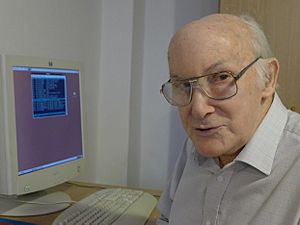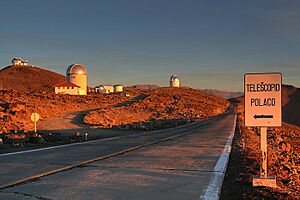Wojciech Krzemiński facts for kids
Quick facts for kids
Wojciech Krzemiński
|
|
|---|---|
 |
|
| Born | 20 May 1933 |
| Died | 5 August 2017 (aged 84) |
| Nationality | Polish |
| Alma mater | University of Warsaw |
| Scientific career | |
| Fields | astrophysics |
| Institutions | NCAC in Warsaw and the Carnegie Institution Observatories |
| Patrons | Polish Academy of Sciences |
Wojciech Krzemiński (born May 20, 1933 – died August 5, 2017) was a Polish astronomer. He was a professor at the Nicolaus Copernicus Astronomical Center in Poland. He also worked for many years at the Carnegie Institution Observatories.
Contents
Early Life and Career
Wojciech Krzemiński studied under famous professors Stefan Piotrowski and Włodzimierz Zonn. In the early 1960s, he worked at the Lick Observatory and Lowell Observatory in the USA. Later in the 1960s, he received a special scholarship. This allowed him to work at the Carnegie Institution.
Working in Chile
In 1973, Krzemiński became the first Polish astronomer to work at the Las Campanas Observatory in Chile. During the 1970s, he worked closely with professors Bohdan Paczyński and Józef Smak.
In the 1980s, he was asked to become the "resident astronomer" at Las Campanas. He held this important job for 16 years. He lived in La Serena, Chile, for many years. He returned to Poland in 2011.
Amazing Discoveries in Space
Wojciech Krzemiński made many important discoveries about stars. He was one of the first to show that certain stars, called cataclysmic variables, are actually two stars.
Understanding Cataclysmic Variables
In the 1960s, Krzemiński and Joseph Taste studied these "cataclysmic variables." They figured out that these are binary star systems. This means they are made of two stars orbiting each other.
One star pulls matter from the other star. This process is called accretion. They also explained how the brightness of these stars changes. This change comes from an accretion disk around one of the stars.
Studying Dwarf Novae
Krzemiński also carefully measured the brightness of dwarf novae. These are stars that suddenly get much brighter. On December 4, 1961, he studied a dwarf nova called U Geminorum.
He noticed that U Geminorum's light would dim regularly. This dimming happened every 4 hours, 14 minutes, and 45 seconds. This was the first clear proof that U Geminorum was a double star system.
How U Geminorum Works
At first, Krzemiński thought the dimming was caused by an uneven surface on a white dwarf star. A white dwarf is a very dense, small star. However, it turned out that the white dwarf itself was not being blocked.
Professor Józef Smak later created a better model. He showed that U Geminorum is a binary system. It has a white dwarf and another star that is filling its Roche surface. This means the second star is so close that its outer layers are being pulled towards the white dwarf.
This pulled matter forms an accretion disk around the white dwarf. There's also a "hot spot" where the matter hits the disk. The dimming of U Geminorum happens when this "hot spot" or the disk itself is blocked by the second star.
Discovering WZ Sagittae
In 1964, Krzemiński and Robert Kraft found that the star WZ Sagittae is also a cataclysmic dwarf nova. This system completes an orbit in just one hour and 22 minutes.
WZ Sagittae is special because it erupts about every 11,000 days. When it erupts, its brightness increases by more than a thousand times! These eruptions likely happen because the accretion disk becomes unstable. This causes a lot more matter to fall onto the white dwarf.
Krzemiński's Star
Wojciech Krzemiński also found the visible star that orbits the X-ray pulsar Centaurus X-3. An X-ray pulsar is a spinning neutron star that sends out beams of X-rays. This companion star was named Krzemiński's Star to honor his discovery.
He was also one of the first astronomers to correctly explain stars like AM Herculis. These are called "polar stars" because they have very strong magnetic fields.
Involvement in Astronomy Groups
Wojciech Krzemiński was a member of the Polish Astronomical Society. He even served as the secretary of its board from 1951 to 1961.


